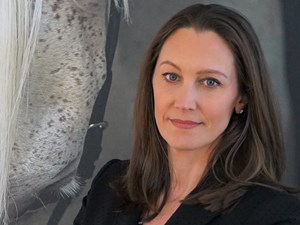Cadillac’s journey from V8 to EV
Iconic US car brand Cadillac is on a transformational journey away from the internal combustion engine to become a world leading, electric vehicle (EV) manufacturer. While investment in innovative new products is critical, success will require new partnerships and new business models to create the infrastructure and support needed to make EVs the vehicle of choice for every customer.

Early next year, US car manufacturer Cadillac begins a new chapter in its 120-year history with the launch of LYRIQ, an all-electric, luxury SUV. It is a first for the brand and a head-turning one for many reasons, Emma Belcher, Associate Director for Global Strategy at Cadillac shares their journey.
Cadillac is an iconic automotive brand and no stranger to innovation. Founded in Detroit in 1902, the firm has pioneered automotive firsts including the synchromesh gearbox, the standard setting overhead valve V8 engine and the incorporation of an electrical system enabling an electric starter, ignition and lighting.
But LYRIQ is more than just a new model; it’s the start of a transformation that will take the car maker, its customers, and partners firmly into the net zero, EV era.
“Cadillac’s EV programme means that while we have entered this decade with only internal combustion engine vehicles in our showroom, we will be in a position to exit the decade with a full portfolio of electric vehicles,” explains Emma Belcher, Associate Director for Global Strategy at Cadillac. “The automotive landscape is changing. I think people are going to be very surprised about how we can delight our customers with our new electric vehicles.”
Everybody In – GM’s commitment to Inclusive Change
This bold strategy is being driven by General Motors (GM), which has owned Cadillac since 1909. GM, of course, also has a proud history of firsts, having given the world innovations such as the starter motor, automatic transmission, turbocharged engines and crash protection air bags.
But most recently – and perhaps most strategically important – the 2017 Bolt EV from GM’s Chevrolet brand model, beat Elon Musk and Tesla to become the world’s first mass produced electric car sold for less than US$30,000 with available tax credit, and cemented the company’s commitment to EVs.
Launched January 2021, Belcher says “with the Everybody In campaign, GM is creating an inclusive movement to usher in the mass adoption of EVs.
The company has committed to investing US$27 billion over the next five years to put, as the marketing campaign name suggests, everybody in an electric vehicle.
This will see the company offer 30 all-electric models globally by mid-decade, transforming 40 percent of the company’s models.
“It’s a strategy that is driven by the company’s overarching 0-0-0 vision, set out by GM chairman and CEO Mary Barra in 2017 to achieve a future of zero crashes, zero emissions and zero congestion,” she adds. The company plans to become carbon neutral by 2040, source 100 percent renewable energy for its global facilities and has an aspiration to eliminate tail pipe emissions from new light-duty vehicles by 2035.
“It's quite a hefty goal and we know that it's going to take some time to get there. But we are pursuing that vision relentlessly,” explains Belcher, pointing out that the desire to be one of the first EV brands resonates across the company.
“The automotive industry fundamentally changed the way people have led their lives over the last century. We are now providing a roadmap for how we transition into a new world,” she adds. “We have to tackle these issues because it's our responsibility to act. And if not us then who; and if not now, then when?”
The US car market
Despite the COVID-19 pandemic cutting global car sales by around 14 percent, Cadillac’s 2020 revenues remained strong in its core US, Canadian and Chinese markets. This ability to buck the trend prompted Cadillac to bring forward launch of the LYRIQ model by nine months.
“Despite a year with unprecedented challenges, and a year where global auto sales were expected to be down 15 percent, Cadillac showed resilience and recorded the brand’s third highest global sales year ever,” adds Belcher, explaining that there is a lot to be excited about at Cadillac.
Moving the huge US car market towards EVs is a key step for Cadillac and parent GM. Although EV sales have increased in the US over the last five years, the market remains slow to embrace the technology. EV sales in the US are just 2 percent of the 14.45 million total cars sold last year - a figure that is growing, but below the pace required to meet GM’s all-electric vision.
Changing the EV narrative to delight customers
Belcher explains that while there are certainly a number of actual and perceived blockers to the US EV transition, in reality technological advances mean that most fears around cost, range, and convenience should now be in the past.
“We have to change the narrative to focus on the advantages of EVs - we have such a huge potential to delight our customers,” she explains highlighting that GM’s new flexible Ultium battery and propulsion platform will create vehicles to suit everyone.
It’s about the performance of these vehicles, the new technology, the environment benefits, the whole driving experience - if you've never driven an EV you really need to get in and try one.
“Electric vehicles provide inclusive solutions across a broad range of market segments due to their design, manufacturing, and performance. They’re an opportunity to redefine Cadillac’s luxury, performance, and technology for a new generation of buyers.”
Customer service beyond the car
For Cadillac, the move to EVs must focus on customer experience. Having the right products is, of course, vitally important. But truly meeting its customer aspiration in this emerging market has required the company to invest in the whole ecosystem that surrounds and supports EVs. It must be easy, desirable, sensible and sustainable to own an EV.
That starts at the dealerships, the primary point of customer contact. This network is being rethought beyond simply providing space to sell and maintain new models; it is now about embedding EVs into the DNA of an established world of internal combustion engine vehicles. “It’s vitally important that everybody engaged in the customer experience has appropriate EV skills and knowledge. It can no longer be a specialist expertise,” says Belcher.
Every member of the team must be able to excite, enthuse and reassure buyers along each step of their EV transition.
“The manufacturer and the dealer need to work together,” says Belcher. “We need to demystify ownership and we need to make those benefits clear. We have to bring the customers with us and that means giving dealers everything they need to deliver this luxury EV experience.”
New partnerships to extend the charging network and transition to zero emissions
But the transition extends beyond the dealership, with investment by GM to extend the public charging infrastructure. GM is collaborating with EVgo, the largest public EV fast charging network provider in the US, to triple their network over the next five years.
“That means adding 2,700 new fast chargers which will help accelerate the adoption of EVs,” explains Belcher. She highlights that a number of other collaborations are being brokered with cities, developers and power companies to support new and existing customers with increased access to charging infrastructure. This will help to embed charging networks into the public realm with the public and the private sector working closely to drive mutual benefit.
We are adding fast chargers in cities and suburbs to help unlock a new segment of EV customer by providing increased charging access to drivers who live in multi-unit dwellings or rent their homes.
New collaborations are also key to delivering GM’s ambition to become a net zero carbon business. In 2020, the company bought 300,000 MW hours of wind energy from DTE, the local Michigan electricity energy company. GM also bought another 800,000 MW hours of wind energy this year as part of the plan to use 100 percent renewable power in all GM facilities in the U.S. by 2030.
“There is a huge commitment required to make this work as it's a very complex undertaking, but we're making significant progress by working and collaborating with many other organizations,” says Belcher. “But it is also very exciting, and I am proud and energized to work for a company which is truly aligned with my own personal passions and values.”

